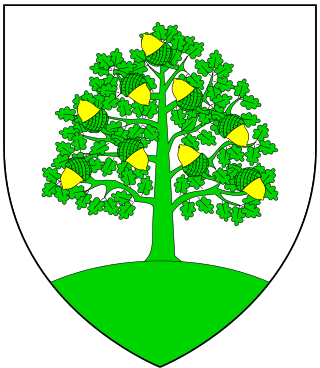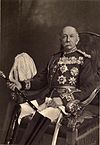
Field Marshal Francis Wallace Grenfell, 1st Baron Grenfell, was a British Army officer. After serving as aide-de-camp to the Commander-in-Chief, South Africa, he fought in the 9th Xhosa War, the Anglo-Zulu War and then the Anglo-Egyptian War. He went on to become Sirdar (Commander-in-Chief) of the Egyptian Army and commanded the forces at the Battle of Suakin in December 1888 and at the Battle of Toski in August 1889 during the Mahdist War. After that he became Governor of Malta and then Commander-in-Chief, Ireland before retiring in 1908.

Field Marshal Sir Henry Evelyn Wood,, DL was a British Army officer. After an early career in the Royal Navy, Wood joined the British Army in 1855. He served in several major conflicts including the Indian Mutiny where, as a lieutenant, he was awarded the Victoria Cross, the highest award for valour in the face of the enemy that is awarded to British and Imperial forces, for rescuing a local merchant from a band of robbers who had taken their captive into the jungle, where they intended to hang him. Wood further served as a commander in several other conflicts, notably the Third Anglo-Ashanti War, the Anglo-Zulu War, the First Boer War and the Mahdist War. His service in Egypt led to his appointment as Sirdar where he reorganised the Egyptian Army. He returned to Britain to serve as General Officer Commanding-in-Chief Aldershot Command from 1889, as Quartermaster-General to the Forces from 1893 and as Adjutant General from 1897. His last appointment was as commander of 2nd Army Corps from 1901 to 1904.

General Sir Francis Reginald Wingate, 1st Baronet, was a British general and administrator in Egypt and the Sudan. He earned the nom de guerre Wingate of the Sudan.
Commander-in-Chief, Ireland, was title of the commander of the British forces in Ireland before 1922. Until the Act of Union in 1800, the position involved command of the distinct Irish Army of the Kingdom of Ireland.

The 1st Regiment of Life Guards was a cavalry regiment in the British Army, part of the Household Cavalry. It was formed in 1788 by the union of the 1st Troop of Horse Guards and 1st Troop of Horse Grenadier Guards. In 1922, it was amalgamated with the 2nd Life Guards to form The Life Guards.

The 2nd Regiment of Life Guards was a cavalry regiment in the British Army, part of the Household Cavalry. It was formed in 1788 by the union of the 2nd Troop of Horse Guards and 2nd Troop of Horse Grenadier Guards. In 1922, it was amalgamated with the 1st Life Guards to form The Life Guards.

The Battle of Toski (Tushkah) was part of the Mahdist War. It took place on August 3, 1889, in southern Egypt between the Anglo-Egyptian forces and the Mahdist forces of the Sudan.

General Sir Archibald Hunter, was a senior officer in the British Army who distinguished himself during the Boer War. He was Governor of Omdurman, in Sudan, and later of Gibraltar.

The Order of the Nile was established in 1915 and was one of the Kingdom of Egypt's principal orders until the monarchy was abolished in 1953. It was then reconstituted as the Republic of Egypt's highest state honor.
Serdar was a military rank in the Ottoman Empire and a noble rank in Montenegro and Serbia. Serdars often served on the borders of the Ottoman Empire. The term is often translated as 'commander' in English texts and comes from persian language.
The British Defence Staff – US, which was previously known as British Joint Staff Mission and British Defence Staff (Washington), is the home of the Ministry of Defence in the United States of America and its purpose is to serve the interests of His Majesty's Government in the US.

The Wood, later Page Wood Baronetcy, of Hatherley House in the County of Gloucester, is a title in the Baronetage of the United Kingdom. It was created on 16 December 1837 for Matthew Wood, Lord Mayor of London from 1815 to 1817 and Whig Member of Parliament for the City of London from 1817 to 1843. The fifth Baronet assumed the additional surname of Page. Two other members of the family have also gained distinction. William Wood, 1st Baron Hatherley, Lord High Chancellor of Great Britain from 1868 to 1872, was the second son of the first Baronet while Field Marshal Sir Evelyn Wood was the fifth son of the second Baronet. Also, Katharine O'Shea, known for her relationship with Charles Stewart Parnell, was the daughter of the second Baronet. The theosophist and political activist Annie Besant, was the great-granddaughter of the 1st Baronet's father.

The Army and Navy Club in London is a private members' club founded in 1837, also known informally as The Rag.
Grenfell is a British luxury fashion house established in 1923 by Sir Wilfred Grenfell and headquartered in London, England. It is known for the "Grenfell cloth", a tough, lightweight and water-resistant cotton fabric.

The Battle of Ginnis was a minor battle of the Mahdist War that was fought on December 30, 1885, between soldiers of the Anglo-Egyptian Army and warriors of the Mahdist State. The battle was caused by the Mahdist blockade of the Ginnis-Kosha Fort, which British commanders hoped to relieve.

Eastern Command was a Command of the British Army.

Colonel Pascoe Christian Victor Francis Grenfell, 2nd Baron Grenfell was a peer in the House of Lords.

Field marshal (FM) has been the highest rank in the British Army since 1736. A five-star rank with NATO code OF-10, it is equivalent to an Admiral of the Fleet in the Royal Navy or a Marshal of the Royal Air Force in the Royal Air Force (RAF). A Field Marshal's insignia consists of two crossed batons surrounded by yellow leaves below the Tudor Crown. Like Marshals of the Royal Air Force and Admirals of the Fleet, Field Marshals traditionally remain officers for life, though on half-pay when not in an appointment or retired. The rank has been used sporadically throughout its history, and was vacant during parts of the 18th and 19th centuries. After the Second World War, it became standard practice to appoint the Chief of the Imperial General Staff to the rank on his last day in the post. Army officers occupying the post of Chief of the Defence Staff, the professional head of all the British Armed Forces, were usually promoted to the rank upon their appointment.
Major-General Sir Henry Hallam Parr was a British Army officer who became General Officer Commanding North-Western District.



















